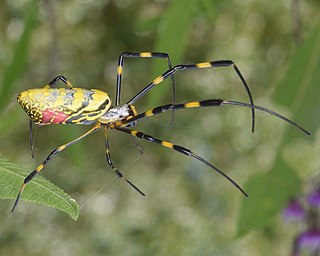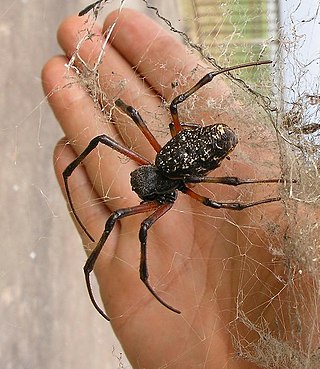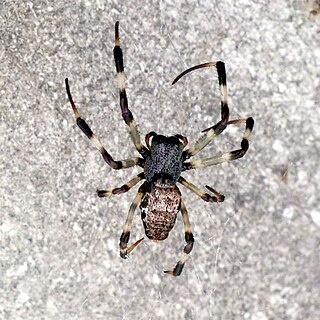
Trichonephila clavata, also known as the Joro spider (ジョロウグモ , is a member of the Trichonephila genus. The spider can be found throughout Japan, Korea, Taiwan, China. Due to its large size and the bright, unique colors of the female Trichonephila, the spider is well-favored in Japan.

Trichonephila edulis is a species of large spider of the family Nephilidae, formerly placed in the genus Nephila. It is referred to by the common name Australian golden orb weaver. It is found in Indonesia from Java eastwards, Papua New Guinea, Australia, northern New Zealand, and New Caledonia.

Nephila pilipes is a species of golden orb-web spider. It resides all over countries in East and Southeast Asia as well as Oceania. It is commonly found in primary and secondary forests and gardens. Females are large and grow to a body size of 30–50 mm, with males growing to 5–6 mm. It is the second largest of the orb-weaving spiders apart from the recently discovered Nephila komaci. The first, second, and fourth pairs of legs of juvenile females have dense hairy brushes, but these brushes disappear as the spider matures.
Nephilengys is a genus of tropical spiders of the family Nephilidae, consisting of two currently described species. The genus Nephilingis has been split off from this genus. Both genera have been called hermit spiders from the habit staying in their retreats during the day; the name eunuch spiders has been used for Nephilengys alone. Males may sever parts of their palpal bulbs after copulation.

Herennia is a genus of spiders in the family Nephilidae, found from India to northern Australia. While two species have been known since the 19th century, nine new species were described in 2005. Spiders in this genus are sometimes called coin spiders.

Clitaetra is a genus of spiders in a family Nephilidae. It occurs in Africa, Madagascar and Sri Lanka, hinting to a Gondwanan origin. a split between Clitaetra and related genera may be as old as 160 million years.

Nephilingis cruentata is an nephilid spider with a strikingly red sternum.

Nephilingis borbonica is an nephilid spider from Réunion. It was once thought to also inhabit Madagascar and other nearby islands, however these were determined in 2011 to be a different species, Nephilingis livida, while specimens from Mauritius were placed in the new species Nephilingis dodo.

Nephilengys malabarensis is an nephilid spider.

Nephilengys papuana is a species of nephilid spider.

Trichonephila plumipes, the Pacific golden orb weaver, is a species of spider found in Australia, Indonesia and some Pacific Islands, which exhibits extreme sexual dimorphism through its sexual cannibalism behavior. It is sometimes called the tiger spider due to its markings which look similar to a tiger. This species was formerly called Nephila plumipes. As with other spiders from the genus Nephila, these spiders have a distinct golden web.

Anelosimus is a cosmopolitan genus of cobweb spiders (Theridiidae), currently containing 74 species. Anelosimus is a key group in the study of sociality and its evolution in spiders. It contains species spanning the spectrum from solitary to highly social (quasisocial), with eight quasisocial species, far more than any other spider genus. Among these is the South American social species Anelosimus eximius, among the best studied social spider species.

Darwin's bark spider is an orb-weaver spider that produces the largest known orb webs, ranging from 900 to 28,000 square centimetres, with bridge lines spanning up to 25 metres (82 ft). The spider was discovered in Madagascar in the Andasibe-Mantadia National Park in 2009. Its silk is the toughest biological material ever studied. Its tensile strength is 1.6 GPa. The species was named in honour of the naturalist Charles Darwin on November 24, 2009—precisely 150 years after the publication of The Origin of Species.

Mongolarachne is an extinct genus of spiders placed in the monogeneric family Mongolarachnidae. The genus contains only one species, Mongolarachne jurassica, described in 2013, which is presently the largest fossilized spider on record. The type species was originally described as Nephila jurassica and placed in the living genus Nephila which contains the golden silk orb-weavers.
Nephilingis dodo is an nephilid spider endemic to Mauritius. It was found to be separate from the related species Nephilingis borbonica in 2011.
Anelosimus pratchetti is a species of tangle-web spider found in New South Wales, Australia. Initial field observations indicate it is a subsocial spider. It lives in low elevation environments, including beachfront mangrove forests. It was identified by Ingi Agnarsson in 2012, who named the species after Terry Pratchett, whom Agnarsson described as "a comic genius".

Herennia multipuncta, commonly known as the spotted coin spider, is a species of spider in the family Nephilidae native to Asia. It exhibits sexual dimorphism, the female being much larger than the male. It weaves a small web on the trunk of a tree or the wall of a building and is well camouflaged by its dappled colouration.

Nephilingis is a genus of spiders in the family Nephilidae. It was split off from the genus Nephilengys in 2006. Both genera have been called hermit spiders from the habit of staying in their retreats during the day; alternatively the name "hermit spider" may be reserved for Nephilingis, with Nephilengys species called "eunuch spiders".

Nephilidae is a spider family commonly referred to as golden orb-weavers. The various genera in Nephilidae were formerly placed in Tetragnathidae and Araneidae. All nephilid genera partially renew their webs.

Artifex melanopyga, synonym Phonognatha melanopyga, referred to as a leaf curling spider, is a common Australian spider found in moist coastal areas of New South Wales and Queensland. A small member of the family Araneidae, the orb-weavers, it was previously placed in Tetragnathidae.
















